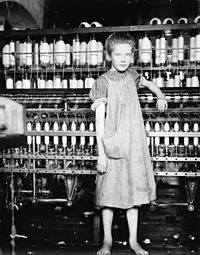- Child labor laws in the United States
-
Child labor laws in the United States include numerous statutes and rules regulating the employment of minors. According to the United States Department of Labor, child labor laws affect those under the age of 18 in a variety of occupations.[1][further explanation needed]
Contents
History of children's labor for wages
 "Addie Card, 12 years. Spinner in North Pormal [i.e., Pownal] Cotton Mill. Vt." by Lewis Hine
"Addie Card, 12 years. Spinner in North Pormal [i.e., Pownal] Cotton Mill. Vt." by Lewis Hine
 Labour Party (UK)
Labour Party (UK)
Labour Party (Ireland)
Australian Labor Party
New Zealand Labour Party
List of other Labour partiesAcademic disciplines
As the US industrialized, factory owners hired young workers for a variety of tasks. Especially in textile mills, children were often hired together with their parents. Many families in mill towns depended on the children's labor to make enough money for necessities.[2]Activism against child labor
The National Child Labor Committee, an organization dedicated to the abolition of all child labor, was formed in 1904. By publishing information on the lives and working conditions of young workers, it helped to mobilize popular support for state-level child labor laws. These laws were often paired with compulsory education laws which were designed to keep children in school and out of the paid labor market until a specified age (usually 12, 14, or 16 years.)
In 1914 the Arkansas state Federation of Labor placed a child welfare initiative on the ballot prohibiting child labor, which the voters passed.[3]
In 1916, the NCLC and the National Consumers League successfully pressured the US Congress to pass the Keating-Owen Act, the first federal child labor law. However, the US Supreme Court struck down the law two years later in Hammer v. Dagenhart (1918), declaring that the law violated a child's right to contract his or her own labor. In 1924, Congress attempted to pass a constitutional amendment that would authorize a national child labor law. This measure was blocked, and the bill was eventually dropped.
It took the Great Depression to end child labor nationwide; adults had become so desperate for jobs that they would work for the same wage as children. In 1938, President Franklin D. Roosevelt signed the Fair Labor Standards Act, which, among other things, placed limits on many forms of child labor.
Currently
Human rights organizations have documented child labor in USA. According to a 2009 petition by Human Rights Watch: "Hundreds of thousands of children are employed as farmworkers in the United States, often working 10 or more hours a day. They are often exposed to dangerous pesticides, experience high rates of injury, and suffer fatalities at five times the rate of other working youth. Their long hours contribute to alarming drop-out rates. Government statistics show that barely half ever finish high school. According to the National Safety Council, agriculture is the second most dangerous occupation in the United States. However, current US child labor laws allow child farmworkers to work longer hours, at younger ages, and under more hazardous conditions than other working youths. While children in other sectors must be 12 to be employed and cannot work more than 3 hours on a school day, in agriculture children can work at age 12 for unlimited hours before and after school." They would work two to three jobs depending on their age.
See also
- Timeline of children's rights in the United States
- United States labor law
References
- ^ "Chapter: Child Labor (Nonagricultural Work)", Compliance Assistance Employment Law Guide. U.S. Department of Labor. Retrieved 8/25/07.
- ^ Cathy L. McHugh (1960), Mill family: the labor system in the Southern cotton textile industry, 1880-1915, New York: Oxford University Press, ISBN 0195042999, 0195042999, http://openlibrary.org/books/OL2379324M/Mill_family; Jacquelyn Dowd Hall (November 1989), Like a Family: the making of a Southern cotton mill world, W W Norton & Co Inc, ISBN 9780393306194, 0393306194, http://openlibrary.org/books/OL7452809M/Like_a_Family
- ^ http://www.ncsl.org/LegislaturesElections/ElectionsCampaigns/BallotMeasuresDatabase/tabid/16580/Default.aspx
External links
Categories:- United States law
- Child labor in the United States
- Laws affecting youth rights
Wikimedia Foundation. 2010.
